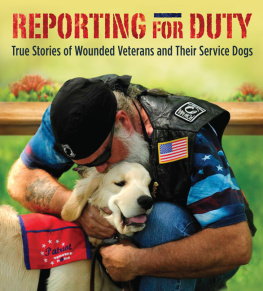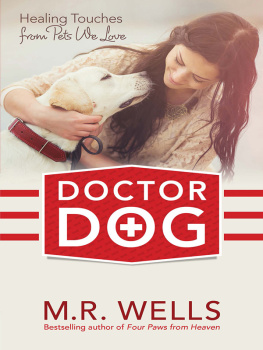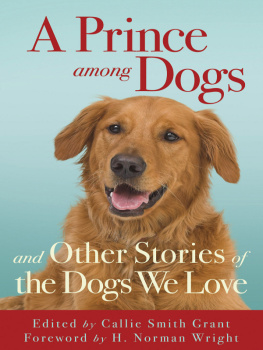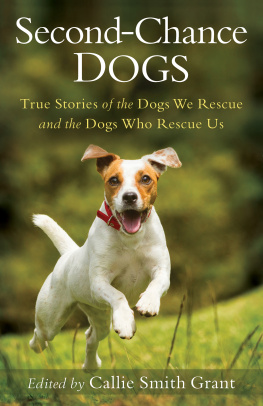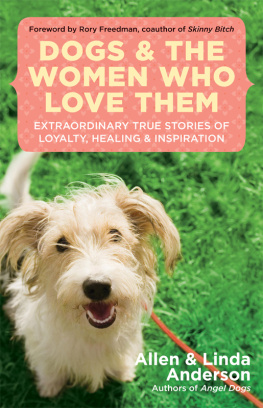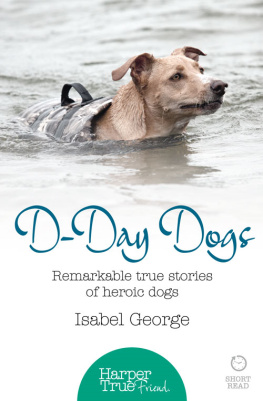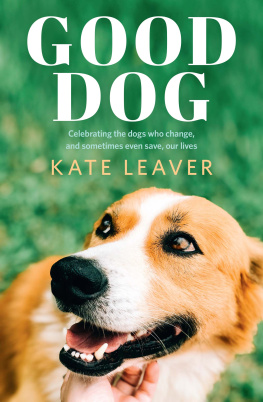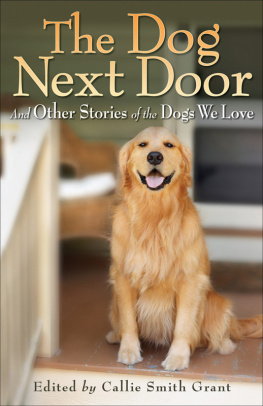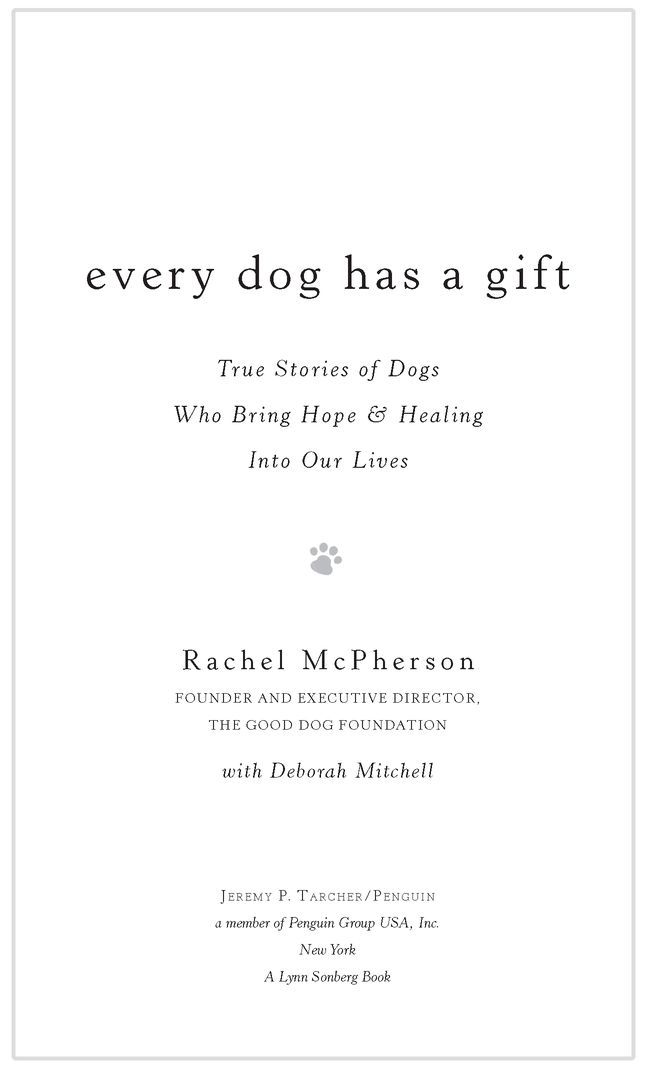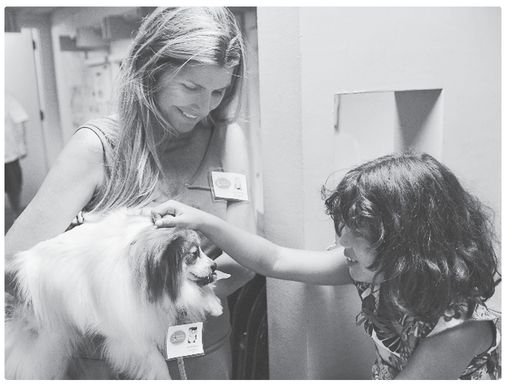Table of Contents
To all the dogs who share their special gifts and help humans heal
INTRODUCTION
In a way, the seeds of this book have been lying dormant for many years. Ever since I was a young child, dogs have been an important and influential part of my life. My passionate belief in the transformational power of the human/dog relationship came to a head in an exciting way about a decade ago when I founded and became executive director of The Good Dog Foundation, a nonprofit organization that is dedicated to all aspects of dog-assisted therapy. Good Dogs bring comfort and joy to people receiving chemotherapy, restore a sense of control to people whose lives have been upended by an illness or disability, serve as the perfect audience to help disadvantaged children practice and improve reading skills, comfort the bereaved and victims of disasters, and much more.
When I founded The Good Dog Foundation, I was bursting with enthusiasm, and today I am reinvigorated daily with the ideas, challenges, joys, and love that come from working with all the terrific dogs, volunteers, staff, and clients of the Foundation. Now I feel it is time for me to share some of the incredibly special moments and stories surrounding the relationship between people and dogs that have blessed and enriched my own life over the years.
First, I want to emphasize my firm belief that each and every dog is a therapy dog. Thats not to say that every dog has gone through a specially designed training program so he or she can behave appropriately in a clinical setting. Im saying that all dogs inherently have the power to heal, and they all want to give love and to be loved in return, even those who appear to act frightened or vicious. And what better therapy is there than love?
In this book we hope to illustrate the power, magnitude, and magic of that love as told in stories that inspire and move readers. I say we because without the cooperation of the volunteers and staff at The Good Dog Foundation, the people who have been the recipients of Good Dog visits, and people from all walks of life across the country who have shared their special dog stories with meand of course the dogs themselvesthis book would not have been possible.
Make no mistake... this is not just a collection of stories about dogs. I have found that when you are dealing with the relationship between dogs and people, the stories go much deeper and stir up more primal, universal emotions. Although we have attempted to group the stories in this book by themehealing and teaching life-changing situations, and the special relationships dogs have with childrenwe know these divisions are artificial and that every life story straddles several domains. Still, it is our hope that these categories may provoke readers to gain a new perspective or open up possibilities for expanding their own relationships with their canine companions.
With that concept in mind, I have also included a section with practical information, called Closing Tails, at the end of each section. Each of these sections offers readers a variety of practical information that ties in with the parts main theme, including, for instance, activities parents and their children can engage in with their dogs at home; training tips; information on volunteer opportunities; contact information on organizations that provide therapy dogs, service dogs, and search-and-rescue dogs; and suggested reading materials.
My goal in sharing these stories and related activities is to help people become more engaged in the relationship they have with dogs and to help them enhance that relationship for themselves and beyond, into the lives of their family, friends, colleagues, and others in the community. My hope is that the stories in this book will not only make people stop and think about dogs in a different way but also introduce them to some of the many constructive, loving, and joyful opportunities there are to interact with dogs in their daily lives.
Why I Wanted to Write This Book
As a child growing up in Mississippi, I understood intuitively that dogs can play critical roles in our lives. I know it was true for me. I have a sister, Ann, who is fifteen years my senior, and I looked up to her. When I was about three years old, Ann went away to college. I was crushed and filled with a great sense of loss. My salvation was Uncle Bud: a French bulldog who became my constant compan-ion and confidant. When Uncle Bud was stolen, I felt as if my best friend had been taken awayagain. Shortly thereafter our family adopted a standard poodle, Fifi, and from then on, all through my teen years and college, and as I entered the work world, dogs continued to be a part of my life. And then a shift occurred.
Rachel McPherson and Good Dog Fidel visiting with Alice at Gildas Club in Manhattan. The Good Dog Foundation makes regular visits to Gildas Club to meet with kids whose lives have been affected by cancer.
I was working as a producer for film and television with my own company, Southern Voices, which produced dramatic adaptations of southern literature, among other endeavors. In 1984, one of my documentaries, Signals Through the Flames, was nominated for an Academy Award in the best documentary film category. In the mid 1990s, in preparation for a documentary that would feature therapy dogs, I began to conduct nationwide research on therapy dogs and the work they do. Although I thought I was already a passionate dog person, I was soon to discover new depths to the incredibly positive impact that one-on-one interactions between people and dogs can have, not only on the direct participants in such relationships, but on close family and friends. I became fascinated with therapy dogs and the healing powers that seemed to magically take hold when an ailing, dying, emotionally distraught, physically challenged, or otherwise hurting or traumatized individual was paired with a therapy dog.
In the midst of my research I learned that it was against the law to take dogs into a hospital in New York. To me, this was an absolute outrage. Here we had the means to bring comfort, joy, pain relief, and love to people in need, essentially without cost or risk of drug-related side effects, and patients were being denied that care. I knew I had to do something. That something grew into several projects, but none of them included the documentary.
Rather than do a film on the subject, I decided to devote my energy to creating The Good Dog Foundation, which was founded in 1998, and changing the law that barred therapy dogs from visiting hospitals and other health care facilities. We succeeded on both counts, and today Good Dogs make more than 260,000 visits to people in health care, social services, and community organizations and schools in New York, New Jersey, Massachusetts, and Connecticut each year. After the work that Good Dogs did at Ground Zero helping the families of victims of 9/11, The Good Dog Foundation created a disaster-response training course for its volunteers. Because of that training, Good Dogs were enlisted by the Mississippi Department of Mental Health to assist families after Hurricane Katrina. The Good Dog Foundation has been honored on the floor of the Westminster Kennel Club Dog Show because of its work with Hurricane Katrina survivors, and has received awards from the American Society for the Prevention of Cruelty to Animals (ASPCA) and the American Red Cross for its work in New York City in the aftermath of the September 11 attacks.


